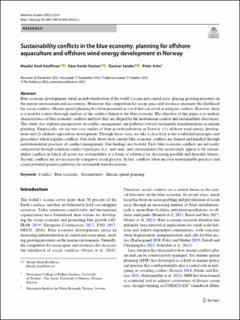| dc.contributor.author | Knol-Kauffman, Maaike | |
| dc.contributor.author | Nielsen, Kåre Nolde | |
| dc.contributor.author | Sander, Gunnar | |
| dc.contributor.author | Arbo, Peter | |
| dc.date.accessioned | 2023-11-14T13:51:40Z | |
| dc.date.available | 2023-11-14T13:51:40Z | |
| dc.date.created | 2023-10-13T09:47:37Z | |
| dc.date.issued | 2023 | |
| dc.identifier.citation | Maritime Studies. 2023, 22, 47. | en_US |
| dc.identifier.issn | 1872-7859 | |
| dc.identifier.uri | https://hdl.handle.net/11250/3102524 | |
| dc.description.abstract | Blue economy developments entail an industrialization of the world’s ocean and coastal areas, placing growing pressures on the marine environment and ecosystems. Moreover, the competition for ocean space and resources increases the likelihood for social conflicts. Marine spatial planning has been presented as a tool that can avoid or mitigate conflicts. However, there is a need for a more thorough analysis of the conflicts linked to the blue economy. The objective of this paper is to analyze characteristics of blue economy conflicts and how they are shaped by the institutional context and sustainability discourses. This study also explores perspectives on conflict management and pathways toward sustainable transformations in marine planning. Empirically, we use two case studies of blue growth industries in Norway: (1) offshore wind energy development and (2) offshore aquaculture development. Through these cases, we take a close look at the established principles and procedures which regulate conflicts. Our study shows how current blue economy conflicts are framed and handled through institutionalized practices of conflict management. Our findings are twofold. First, blue economy conflicts are not easily categorized through common conflict typologies (i.e., user-user, user-environment) but increasingly appear to be sustainability conflicts in which all actors use sustainability as a frame of reference for discussing possible and desirable futures. Second, conflicts are not necessarily a negative social process. In fact, conflicts often uncover unsustainable practices and create potential positive pathways for sustainable transformations. | en_US |
| dc.description.abstract | A correction to this article has been made. The file here is the updated version. Notes on the correction found here: https://link.springer.com/article/10.1007/s40152-023-00342-0 | en_US |
| dc.language.iso | eng | en_US |
| dc.publisher | Springer | en_US |
| dc.rights | Navngivelse 4.0 Internasjonal | * |
| dc.rights.uri | http://creativecommons.org/licenses/by/4.0/deed.no | * |
| dc.title | Sustainability conflicts in the blue economy: planning for offshore aquaculture and offshore wind energy development in Norway | en_US |
| dc.type | Peer reviewed | en_US |
| dc.type | Journal article | en_US |
| dc.description.version | publishedVersion | en_US |
| dc.rights.holder | © 2023 The Authors | en_US |
| dc.source.pagenumber | 14 | en_US |
| dc.source.volume | 22 | en_US |
| dc.source.journal | Maritime Studies | en_US |
| dc.identifier.doi | https://doi.org/10.1007/s40152-023-00335-z | |
| dc.identifier.cristin | 2184346 | |
| dc.source.articlenumber | 47 | en_US |
| cristin.ispublished | true | |
| cristin.fulltext | original | |
| cristin.qualitycode | 1 | |

